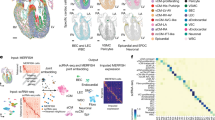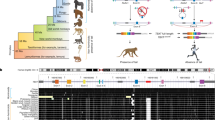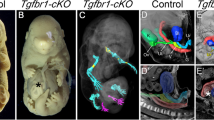Abstract
Laterality of the internal organs of vertebrates is determined by asymmetric Nodal signalling in the lateral plate mesoderm1. A deficiency of such signalling results in heterotaxia syndrome, characterized by anomalous laterality of visceral organs and complex congenital heart conditions1. Pitx2, the transcription factor induced by the Nodal signal, regulates left–right asymmetric morphogenesis1,2,3,4. The cellular and molecular bases of asymmetric morphogenesis remain largely unknown, however. Here we show that ablation of unilateral Pitx2 expression in mice impairs asymmetric remodelling of the branchial arch artery (BAA) system, resulting in randomized laterality of the aortic arch. Pitx2-positive cells were found not to contribute to asymmetrically remodelled arteries. Instead, Pitx2 functions in the secondary heart field5 and induces a dynamic morphological change in the outflow tract of the heart, which results in the provision of an asymmetric blood supply to the sixth BAA. This uneven distribution of blood flow results in differential signalling by both the platelet-derived growth factor receptor and vascular endothelial growth factor receptor 2. The consequent stabilization of the left sixth BAA and regression of its right counterpart underlie left-sided formation of the aortic arch. Our results therefore indicate that haemodynamics, generated by a Pitx2-induced morphological change in the outflow tract, is responsible for the asymmetric remodelling of the great arteries.
This is a preview of subscription content, access via your institution
Access options
Subscribe to this journal
Receive 51 print issues and online access
$199.00 per year
only $3.90 per issue
Buy this article
- Purchase on Springer Link
- Instant access to full article PDF
Prices may be subject to local taxes which are calculated during checkout




Similar content being viewed by others
References
Hamada, H., Meno, C., Watanabe, D. & Saijoh, Y. Establishment of vertebrate left–right asymmetry. Nature Rev. Genet. 3, 103–113 (2002)
Shiratori, H., Yashiro, K., Shen, M. M. & Hamada, H. Conserved regulation and role of Pitx2 in situs-specific morphogenesis of visceral organs. Development 133, 3015–3025 (2006)
Liu, C. et al. Pitx2c patterns anterior myocardium and aortic arch vessels and is required for local cell movement into atrioventricular cushions. Development 129, 5081–5091 (2002)
Liu, C. et al. Regulation of left-right asymmetry by thresholds of Pitx2c activity. Development 128, 2039–2048 (2001)
Buckingham, M., Meilhac, S. & Zaffran, S. Building the mammalian heart from two sources of myocardial cells. Nature Rev. Genet. 6, 826–835 (2005)
Shiratori, H. et al. Two-step regulation of left-right asymmetric expression of pitx2: Initiation by nodal signaling and maintenance by Nkx2. Mol. Cell 7, 137–149 (2001)
Becker, A. & Anderson, R. in Pathology of Congenital Heart Disease (ed. Crawford, T.) 321–337 (Butterworths, London, 1981)
Yanagisawa, H. et al. Role of endothelin-1/endothelin—a receptor-mediated signaling pathway in the aortic arch patterning in mice. J. Clin. Invest. 102, 22–33 (1998)
Hiruma, T., Nakajima, Y. & Nakamura, H. Development of pharyngeal arch arteries in early mouse embryo. J. Anat. 201, 15–29 (2002)
Waldo, K. & Kirby, M. in Living Morphogenesis of the Heart (eds de la Cruz, M. & Markwald, R.) 187–217 (Birkhäuser, Boston, MA, 1998)
Jiang, X. et al. Fate of the mammalian cardiac neural crest. Development 127, 1607–1616 (2000)
Ai, D. et al. Pitx2 regulates cardiac left–right asymmetry by patterning second cardiac lineage-derived myocardium. Dev. Biol. 296, 437–449 (2006)
Sharpe, J. et al. Optical projection tomography as a tool for 3D microscopy and gene expression studies. Science 296, 541–545 (2002)
Bajolle, F. et al. Rotation of the myocardial wall of the outflow tract is implicated in the normal positioning of the great arteries. Circ. Res. 98, 421–428 (2006)
Rychter, Z. Experimental morphology of the aortic arches and the heart loop in chick embryos. Adv. Morphog. 2, 333–371 (1962)
Phoon, C. K., Aristizabal, O. & Turnbull, D. H. 40 MHz doppler characterization of umbilical and dorsal aortic blood flow in the early mouse embryo. Ultrasound Med. Biol. 26, 1275–1283 (2000)
Carmeliet, P. Angiogenesis in health and disease. Nature Med. 9, 653–660 (2003)
Gittenberger-de Groot, A. C., Azhar, M. & Molin, D. G. Transforming growth factor β-Smad2 signaling and aortic arch development. Trends Cardiovasc. Med. 16, 1–6 (2006)
Tallquist, M. D. & Soriano, P. Cell autonomous requirement for PDGFRα in populations of cranial and cardiac neural crest cells. Development 130, 507–518 (2003)
Stalmans, I. et al. Vegf: A modifier of the del22q11 (DiGeorge) syndrome? Nature Med. 9, 173–182 (2003)
Abu-Issa, R. et al. Fgf8 is required for pharyngeal arch and cardiovascular development in the mouse. Development 129, 4613–4625 (2002)
Phillips, H. M. et al. Vangl2 acts via RhoA signaling to regulate polarized cell movements during development of the proximal outflow tract. Circ. Res. 96, 292–299 (2005)
Vitelli, F. et al. A genetic link between Tbx1 and fibroblast growth factor signaling. Development 129, 4605–4611 (2002)
Yashiro, K. et al. Regulation of retinoic acid distribution is required for proximodistal patterning and outgrowth of the developing mouse limb. Dev. Cell 6, 411–422 (2004)
Uehara, M. et al. CYP26A1 and CYP26C1 cooperatively regulate anterior–posterior patterning of the developing brain and the production of migratory cranial neural crest cells in the mouse. Dev. Biol. 302, 399–411 (2007)
Takeuchi, J. K. et al. Tbx20 dose-dependently regulates transcription factor networks required for mouse heart and motoneuron development. Development 132, 2463–2474 (2005)
Li, L., Miano, J. M., Mercer, B. & Olson, E. N. Expression of the SM22α promoter in transgenic mice provides evidence for distinct transcriptional regulatory programs in vascular and visceral smooth muscle cells. J. Cell Biol. 132, 849–859 (1996)
Acknowledgements
We thank S. Iseki, A. McMahon and H. Sucov for Wnt1-Cre mice; the staff of MRC Technology in Edinburgh for technical assistance with OPT; K. Yamashita for transgene construction; K. Mochida, S. Ohishi and Y. Ikawa for general technical assistance; Primetech Corp. for technical assistance with Vevo770; and P. Soriano, T. Kubo, K. Ozono, T. Sano, T. Matsusita, S. Kogaki and the cardiologists in the Department of Pediatrics, Osaka University Medical School, for advice. This work was supported by grants (to H.H.) from the Ministry of Education, Culture, Sports, Science, and Technology of Japan and by CREST.
Author Contributions Project planning was mainly performed by K.Y.; most of the experiments were carried out by K.Y. and the remaining experiments by H.S. and H.H.; the manuscript was written by K.Y. and H.H.
Author information
Authors and Affiliations
Corresponding authors
Ethics declarations
Competing interests
The authors declare no competing financial interests.
Supplementary information
Supplementary Information
This file contains Supplementary Discussion 1-2, Supplementary Tables S1-S2, additional references, Supplementary Figures S1-S7 with Legends and Supplementary Videos 1-9 Legends (PDF 1435 kb)
Supplementary Video 1
The file contains Supplementary Video 1 which shows the appearance of a control (unligated) cultured embryo. This movie shows that the viability of the control embryos in the artery ligation experiment could not be affected. (MOV 849 kb)
Supplementary Video 2
The file contains Supplementary Video 2 which shows the appearance of a ligated cultured embryo. This movie shows the ligation of the left branchial arch arteries could not affect the viability of the embryos. (MOV 316 kb)
Supplementary Video 3
The file contains Supplementary Video 3 which shows the blood supply in the left BAAs of the control embryo shown in Supplementary Video 1. This movie shows the intact blood supply into the left side branchial arch arteries in the unligated embryos. (MOV 2346 kb)
Supplementary Video 4
The file contains Supplementary Video 4 which shows the loss of blood supply in the left BAAs of the ligated embryo shown in Supplementary Video 2. This movie shows the loss of blood supply into the left side branchial arch arteries in the ligated embryos. (MOV 1564 kb)
Supplementary Video 5
The file contains Supplementary Video 5 which shows the appearance of a control embryo cultured with vehicle (DMSO) alone. This movie shows that the culture condition without the inhibitors could not affect the viability of the embryos (MOV 560 kb)
Supplementary Video 6
The file contains Supplementary Video 6 which shows the appearance of an embryo cultured with VEGFR inhibitor (2 μM) and AG1296 (50 μM). This movie shows that the culture condition with VEGFR inhibitor and AG1296 could not affect the viability, the appearance, and the major vessels of the embryos. (MOV 548 kb)
Supplementary Video 7
The file contains Supplementary Video 7 which shows the appearance of an embryo cultured with AG1433 (10 μM).This movie shows that the culture condition with AG1433 could not affect the viability, the appearance, and the major vessels of the embryos. (MOV 573 kb)
Supplementary Video 8
The file contains Supplementary Video 8 which shows the appearance of an embryo cultured with propranolol (10 μM).This movie shows that propranolol (10μM) could reduce the heart rate significantly. (MOV 657 kb)
Supplementary Video 9
The file contains Supplementary Video 9 which shows the appearance of an embryo cultured with propranolol (25 μM). This movie shows that the bradicardia induced by propranolol (25μM) was more significant than by propranolol (10M). (MOV 892 kb)
Rights and permissions
About this article
Cite this article
Yashiro, K., Shiratori, H. & Hamada, H. Haemodynamics determined by a genetic programme govern asymmetric development of the aortic arch. Nature 450, 285–288 (2007). https://doi.org/10.1038/nature06254
Received:
Accepted:
Issue Date:
DOI: https://doi.org/10.1038/nature06254
Comments
By submitting a comment you agree to abide by our Terms and Community Guidelines. If you find something abusive or that does not comply with our terms or guidelines please flag it as inappropriate.



